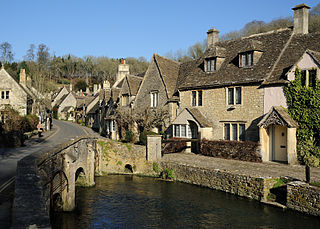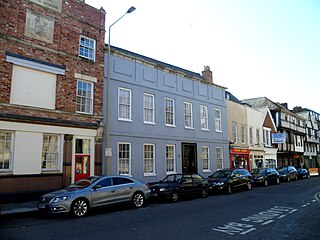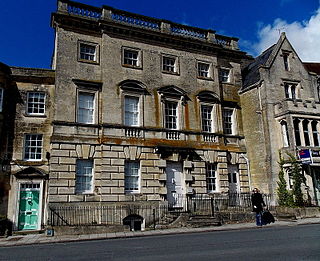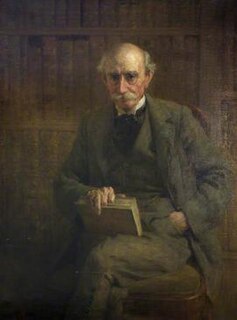
The Cotswolds is an area in south-central, West Midlands and South West England comprising the Cotswold Hills, a range of rolling hills that rise from the meadows of the upper Thames to an escarpment, known as the Cotswold Edge, above the Severn Valley and Evesham Vale.

Gloucestershire is a county in South West England. The county comprises part of the Cotswold Hills, part of the flat fertile valley of the River Severn, and the entire Forest of Dean.

Stroud is a market town and civil parish in the centre of Gloucestershire, England. It is the main town in Stroud District.

Painswick is a town and civil parish in Gloucestershire, England. Originally the town grew from the wool trade, but it is now best known for its parish church's yew trees and the local Rococo Garden. The village is mainly constructed of locally quarried Cotswold stone. Many of the buildings feature south-facing attic rooms once used as weavers' workshops.

Baron Dickinson, of Painswick in the County of Gloucester, is a title in the Peerage of the United Kingdom. It was created on 18 January 1930 for the Liberal politician Willoughby Dickinson, who had previously represented St Pancras North in the House of Commons. He was the son of Sebastian Dickinson, Member of Parliament for Stroud from 1868 to 1874. As of 2019 the title is held by the first Baron's great grandson, the third Baron, who succeeded in 2019.

Sheepscombe is a small village in the English county of Gloucestershire. Sheepscombe is located some 6.5 miles (10 km) south-east of the city of Gloucester, 6 miles (10 km) north-east of the town of Stroud, and 1.5 miles (2 km) east of the village of Painswick. It lies in a narrow valley, hidden behind the Cotswold scarp, and just off the A46 and B4070 roads.

Stanway House is a Jacobean manor house, located near the village of Stanway in Gloucestershire, England. The manor of Stanway was owned by Tewkesbury Abbey for 800 years then for 500 years by the Tracy family and their descendants, the Earls of Wemyss and March.

Miserden is a village and civil parish in Stroud District, Gloucestershire, England, 4 miles north east of Stroud. The parish includes Whiteway Colony and the hamlets of Sudgrove and The Camp. In the 2001 census the parish had a population of 420, increasing to 449 at the 2011 census.

Boxwell Court is a country house near Leighterton in Gloucestershire, England, dating from the 15th and 16th century. It is a Grade II* listed building.

Bull Cross, The Frith and Juniper Hill is a 42.33-hectare (104.6-acre) biological and geological Site of Special Scientific Interest in Gloucestershire, notified in 1954. The site is listed in the ‘Stroud District’ Local Plan, adopted November 2005, Appendix 6 as an SSSI and Regionally Important Geological Site (RIGS).
Charles Hyett, of Painswick House, near Gloucester, Gloucestershire, was an English politician.

Hyatt House, or Hyett House, is a grade II listed building at 91 Westgate Street in the English city of Gloucester. The building is of a timber frame with stone and was probably constructed in the 16th century. According to a plaque on the building, an earlier dwelling stood on the site at least as early as 1455. The current façade was probably constructed by Nicholas Hyett (1709–1777), a local lawyer and justice of the peace. In 1988 the building was converted to flats by Avondown Housing Association and Gloucester City Council.

Nicholas Hyett (1709-1777) was a lawyer and justice of the peace in Gloucester, England, and one of the last keepers and constables of the Castle of Gloucester.

Thomas Robins the Elder (1715/16–1770) was an English artist known for his depictions of English country houses and their gardens. His work has particular historical value as he documented many Rococo gardens that have since disappeared.

Benjamin Hyett II (1708–1762) was the owner of Painswick House, now a grade I listed building, which he inherited from his father the member of Parliament Charles Hyett. His father built the house to escape the smog of Gloucester but died soon after it was completed.

Beacon House is a grade I listed townhouse at New Street, Painswick, Gloucestershire, England.
The Court House is a grade I listed house in Hale Lane, Painswick, Gloucestershire, England, within the Cotswolds.

Sir Francis Adams Hyett (1844–1941) was chairman of Gloucestershire County Council from 1918 to 1920.

Hillfield Gardens is a public park on London Road, Gloucester, England. It houses several historical monuments. The description in December 2020 stated: "Now a Council-owned public park covering about 1.6 hectares, Highfield Gardens is supported by an active Friends group which organises annual events".

Holcombe House is a large Grade II* listed country house located near Painswick, Gloucestershire. The house is a fine example of an Arts and Crafts Cotswolds manor house.


















